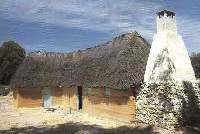
 |
Route 27 West Coast South AfricaWest Coast Towns: Hopefield |
West Coast R27 Route 27 West Coast Towns Off the Beaten Track West Coast History Culture & History From Crayfish to Iron West Coast Map West Coast Explorer SA West Coast Tours/Recreation Nature Reserves Fossil Park Sea Tales & Wrecks Whale Watching Weskus Stories |
 Hopefield is half way between Malmesbury and Vredenburg, 115 km from Cape Town. The town is well known for its annual fynbos show. In spring the area surrounding the town, particularly towards Berg River Station and Langebaan Road, becomes a multicoloured tapestry of flowers and heath. The fynbos in this area is unique and attracts large numbers of tourists each year. Hopefield is half way between Malmesbury and Vredenburg, 115 km from Cape Town. The town is well known for its annual fynbos show. In spring the area surrounding the town, particularly towards Berg River Station and Langebaan Road, becomes a multicoloured tapestry of flowers and heath. The fynbos in this area is unique and attracts large numbers of tourists each year.The town is situated along the eastern bank of the creek which turns into a river in winter. As a result, it is always attractively green around the town. Fossils were discovered, including the skull of the so-called 'Saldanha Man', a replica of which is part of the display in the information office picturing life in the region some five hundred thousand years ago. The nearby Fossil Park is a treat for all visitors to the west coast.
Historical BackgroundPermission to establish a separate parish of the Dutch Reformed Church in the area was given in 1851, the parish to be known as Zoute Rivier. In the following year, permission was sought for the establishment of a town, which was granted in May 1853. The name 'Hopefield' was announced in the Government Gazette dated 11 May 1853, in honour of the incumbent Secretary of the Government and the "collecteur der Douane."Mr PP Kotze was the spokesman for a number of local farmers who had bought a farm (apparently Matjiesfontein) at an auction and requested permission to exchange the farm for a portion of the farm Lange Kuil, which belonged to a Mr Dirk Visser because the latter farm was more suitable for the establishment of a town. The corner stone of the orginal church was laid on 8 January 1877 and the inauguration was on 3 September 1879. When the building became too small, the wings and steeple were added and the Forster & Andrews organ (one of only ten in South Africa) was installed. The inauguration of the enlarged church and new organ being was held on 20 December 1911. Even though a management committee was appointed by the inhabitants in 1903, the church council retained jurisdiction over all matters until the town became a municipality in 1914. Before the modern West Coast road was built, the road between Cape Town and Saldanha went through Hopefield. The rail link with Vredenburg passes through the town, and the first passenger train stopped here on 28 February 1903. The rail link with Cape Town contributed significantly to the development of the Sandveld. In 1945 a bridge was built across the Salt River and this significantly improved contact with the surrounding area, particularly during winter. In the same year the first road in the town was tarred.
My appreciation to Mr Tielman Klynsmith, chairman of Hopefield Tourism Bureau, for providing updated information on Hopefield. Visitors can contact the Hopefield Tourism Bureau at Tel: (022) 723 1010 or write to PO Box 191, Hopefield 7355. |